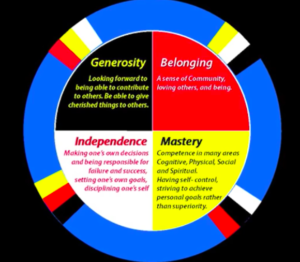Topic three, “Equity and Access in K-12 Distributed (Online) & Open Learning Environments,” consisted of three different readings of all different modalities. The first: Basham, Blackorby, Stahl, & Zhang, L. (2018), is an academic article that explained the framework and reasoning behind the Universal Design for Learning (UDL).
“A scientifically valid framework for guiding educational practice that-(A) provides flexibility in the ways information is presented, in the ways, students respond or demonstrate knowledge and skills, and in the ways, students are engaged; and (B) reduces barriers in instruction, provides appropriate accommodations, supports, and challenges, and maintains high achievement expectations for all students, including students with disabilities and students who are limited English proficient.”
(Basham, Blackorby, Stahl, & Zhang, L., 2018)
In this article, we learned that UDL has been around in education for two decades and created originally, to provide equal and effective inclusion for students with disabilities or diverse learning needs (Basham, Blackorby, Stahl, & Zhang, L., 2018). UDL is now a model designed for all learners, however, it still has the same ideals of providing equity for all learners in their education. In the article, the authors give us a variety of terms from research studies that give way to the idea of creating equity in an online classroom:
- Personalized learning: Patrick, Kennedy, and Powell (2013) state that personalized learning is equivalent to creating an environment where each learners’ inherent strengths, interests, and needs are prioritized. The circle of courage is mentioned in this statement as this encourages a sense of mastery towards the learner.
- Blended learning: Christensen, Horn, and Staker (2013) define blended learning as a type of learning where students learn through online learning and over-time can manage the time,path, pace, and place over their learning. This provides a sense of independence from the circle of courage and allows students equity through having their learning fit the inherent needs of their choice.
- Supplemental online courses: This type of online learning is given when students are unable to base on their schedule, age, or geographic location to take a certain course. In this case, instead of taking the course face-to-face students are allowed to take it instead online
- Competency/proficiency-based learning: Patrick et al., (2013) acknowledge the fact that students are more likely than not to be grouped in categories that have very little to do with their likes and knowledge. The system of grouping learners based on their age does not give in to the fact that many students are not cognitively at the same level as their age bracket. To create a sense of equity for the students: it would be more appropriate to group them by actual cognitive grade level.
The article also gives the reader some statistics around the  current population enrolled in online learning and how these numbers relate to the diversity of the learners enrolled:
current population enrolled in online learning and how these numbers relate to the diversity of the learners enrolled:
2.2 million students take complemental online courses
White students make up 75% of the current online students
There is an expected increase in traditionally marginalized populations within online settings
Less than 25% of online students are Hispanic, 13% are Black, 2% or less are Asian, and 1% of online students are Native American
Students with disabilities make up 7.2% of online students
Students at or below the poverty level comprised 45% to 48% of online enrollment in contrast to making up 35% in face-to-face settings
“Clearly the practice of K-12 education, in general, and the growing presence of online learning needs to become more effective in supporting the strengths and addressing the weaknesses of the students for whom they are responsible.”
(Basham, Blackorby, Stahl, & Zhang, L., 2018)
The second reading by Kral, & Schwab (2012) is a more multimodal article that gives us a list of design principles that should be considered when building and facilitating a learning environment. These principles are a way for us to answer our blog guiding question as they work towards creating equity in the classroom and are created to provide equal opportunities for learners of all contexts. The real-life example the article gives us is of first nations in Australia where they put context to these principles.
- Design Principle 1: Space young people control
- Sites where young people feel a sense of spatial control
- Here, young adults not only have access to resources of a wide variety of learning
- Having access to even the smallest power over technology increases a sense of confidence that extends to enacting decisions elated to difficult situations in everyday life (Mastery)
- There is freedom for individual specializations to emerge

- Design Principle 2: A space for hanging out and “mucking around”
- “The digital bedroom” is one of the most vibrant kids of digital learning spaces for youth
- Informal learning spaces such as media centers, youth centers, and libraries perform an important function as “communal digital bedrooms.”
- Allow for engagement, develop skills, create media and increasingly take on professional and leadership roles
- In these spaces, ‘there is no right or wrong way’ for learning or participation, and everybody is ‘set up to succeed.’
Learning capacity:
“To think for yourself, decide for yourself, you have the power to change that whole scene with the edit. You gain the confidence to make those decisions, to stand strong in what you believe, and what you see and what you think is best for yourself and other people.”
(Kral, & Schwab, 2012)
-
- In these spaces, they are free to ‘hang out’ and experiment and to share and learn from one another.
- Design Principle 3: Space where learners learn
- Focus on the crucial enabling role played by facilitators/mentors’ in the learning process
- These facilitators do not see themselves as ‘bosses’ but give agency to the young people they are working with
- They work in a highly collaborative and respectful manner, show respect and interest in the language and culture of the learners
- Design Principle 4: A space to grow into new roles and responsibilities
- Provide opportunities for young adults to participate in project-based learning and take on responsible goal-oriented roles
- Design Principle 5: A space to practice oral and written language
- Importance of youth engagement in youth-based organizations for language development.
- An important feature of learning spaces is their capacity to provide a place where children can practice their learning, including literacy
- While this may be enabled just by having access to the resources needed for alphabetic or digital literacy activities, in some cases literacy support was provided
“The best way to learn is to do it, get in there, get your hands dirty, get on there, play with it…”
(Kral, & Schwab, 2012)
- Design principle 6: A space to express self/cultural identity through multimodal forms
- Young people are experiencing self-directed, creative, and meaningful productive activity enabled by access to resources and a sense of spatial control
“It is evident that where young people have access to digital resources and technologies, they are engaging in new forms of media production to express themselves and their cultures.”
(Kral, & Schwab, 2012)
-
- The visual and creative aspects of multimedia work show the cultural practices and symbol structures in image and language that learners are using for identity formation
- Design Principle 7: A space to develop and engage in enterprise
- In the article, they found successful economic enterprises generated by youth int their communities, often around shared cultural belief systems
- Design Principle 8: A space to engage with the world
- Through music, theatre, film, and various social media, youth are engaging with the world.
- Through these means, they showcase their skills and creations and cultures.
- Their experience is one in which their culture is both preserved and celebrated
- Festivals provide an opportunity for young people to set their minds to producing music or theatre performances or films
- All these settings provide a space for young people to express their own identity and engage with the world on their terms
- Through music, theatre, film, and various social media, youth are engaging with the world.
Finally, the last reading, a blog post by Selwyn (2020), gives us clear insight into how learning design is now; based on the needs of students in the Covid-19 pandemic.
The impacts Covid-19 has had on our students and teachers (as stated in my blog) has also affected the variety of learning settings including online school.

“After young people being taught through google classroom and zoom lessons, it is reasoned – we’ll have to seriously consider the prospect of online education taking on a more prominent role as school systems adjusts to the post-pandemic world.”
(Selwyn, 2020)
It is shocking how fast the world of education changed in the matter of just days and how this changeover altered the views of online and distributed learning. As stated by the reading, what happened in months is not equivalent to the research on how impactable online learning can be. There was no thought to think of the “educational inequities” behind the choices that were made by teachers and students because there was simply no time. With a change from students coming to a face-to-face classroom now having to have access to the internet, technology, and time there was utter chaos and frustration from all parties. At this moment, teachers could truly understand the “not one size fits all” assumptions that come with education and learning design. There were issues of Digital flexibility, Timing flexibility, and overall Student participation. Covid-19 has shown teachers just how big of a deal it is to create a learning setting that is unique and customizable for each student and has shown us what happens if it isn’t.
References
Basham, J.D., Blackorby, J., Stahl, S. & Zhang, L. (2018) Universal Design for Learning Because Students are (the) Variable. In R. Ferdig & K. Kennedy (Eds.), Handbook of research on K-12 online and blended learning (pp. 477-507). Pittsburgh, PA: Carnegie Mellon University ETC Press.Masters, G. (2018, April 30)
Kral, I. & Schwab, R.G. (2012). Chapter 4: Design Principles for Indigenous Learning Spaces. Safe Learning Spaces. Youth, Literacy and New Media in Remote Indigenous Australia. ANU Press .http://doi.org/10.22459/LS.08.2012 Retrieved from: https://press.anu.edu.au/publications/learning-spaces %EF%BB%B
Selwyn. N. (2020). Online learning: Rethinking teachers’ ‘digital competence’ in light of COVID-19. [Weblog].

Kirby, I enjoyed your post again this week. Like I mentioned to our two partners previously, I have found a source of enjoyment and detachment from the horrid reality that has been 2020 to this point, in all of your blog posts.
I am happy to see you incorporated a few of the same formatting design decisions that you have previously, such as embedding images and isolating quotes as separate paragraphs. Both techniques give your blog a professional quality.
Your last paragraph read like an expert composed it, and I felt like it was written by somebody with a great understanding of current events and how they have affected the teaching community.
Again, I feel like your blog is evidence of the skills and knowledge that you possess that will enable you to be a very successful teacher, some children in the future are going to be very lucky to learn in your classroom.
P.S. This is the first time I have the opportunity to work with you on school projects, and I hope it is not the last because I have enjoyed it very much. You were a valuable asset to our team, and I know that Josh and Leona would agree with me on this!
Another wonderful blog post Kirby! As Timm mentioned, I really liked how you formatted your post using isolated quotes and embedded images – not only does it help with highlighting the most important information, but it also makes it super engaging to read!
I also appreciated how in-depth you went into your explanation of Kral and Schwab’s eight learning design principles. Providing detailed examples of how to support each principle and tying it back to the Circle of Courage helped give me a better understanding of how to work towards creating an equitable and accessible classroom that addresses the whole of each learner.
It’s been such a pleasure reading your posts and working with you throughout this course! I can’t wait to see what you explore for topic 4 🙂